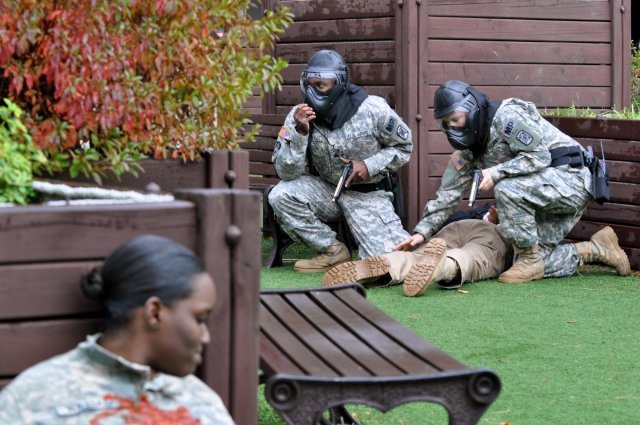“EXERCISE, EXERCISE, EXERCISE!” echoing across U.S. Army Garrison Yongsan signaled the start of the annual full-scale exercise held here, Oct. 15-19. USAG Yongsan’s first responders were put to the test as they were presented with various scenarios, which measured the garrison’s ability to properly handle emergency situations.
“The goal for the full-scale exercise is to test our plans for emergency preparedness and anti-terrorism,” said Robert Daul, anti-terrorism officer for USAG Yongsan. “This will give us a chance to exercise our standard operating procedures and our capabilities, and have external evaluators to see what lessons we can learn and how we can improve safety for the garrison and the community.”
The scenarios for the exercise included a suspicious vehicle, an active shooter and a helicopter crash. Each scenario targeted the readiness of various emergency responder teams including military police, medical and traffic control. Daul explained, however, that during the exercise, the garrison itself was being tested for readiness and how well it would respond to an emergency.
The suspicious vehicle scenario allowed the garrison to evaluate the security measures used when allowing vehicles into the base. In the scenario, one of the vehicles entering the garrison was loaded with two bombs — one hidden in the trunk, and another placed underneath the vehicle. The simulation showed that the procedures used by the garrison allowed such improvised explosive devices, or IEDs, to be detected. Additionally, the Explosive Ordnance Disposal team was tested on their procedures and equipment for bomb removal.
During the active shooter scenario, Sgt. Edward Johnson, patrol supervisor for the 142nd Military Police Company, and his crew of two other military police service members, were tasked with taking down an armed shooter at the Dragon Hill Lodge. His crew managed to successfully remove the threat in a matter of a few minutes with no casualties, which demonstrated that their planning and training were effective. Medical support was also immediately present to provide proper care for wounded service members and Civilians.
“We entered the building to eliminate the threat and even though it was our first time as a team, we did well,” Johnson said. “We came in, had a plan, and carried it out.”
Johnson explained that although the military police conducted training often, it was the exercise which allowed the team to evaluate themselves and understand that their standard operating procedures, known as SOPs, were working properly.
The helicopter crash scenario evaluated the effectiveness of the fire crew in removing possible flames and extricating wounded service members and civilians from the helicopter and the vicinity. It also allowed medical support to measure their ability to immediately provide the proper care needed for victims.
“Overall, we evaluated the readiness of USAG Yongsan to be great,” said Felicia Jackson, chief evaluator for the full-scale exercise and also the director of Plans, Training, Mobilization and Security for Fort Wainwright. “There were several areas that the garrison was well-trained in and we didn’t see any significant short falls.”
Jackson said that one of USAG Yongsan’s biggest strengths was its ability to utilize its on-post Closed Circuit Television, or CCTV, system. USAG Yongsan was able to view an emergency that was happening on the installation from inside its own Information Operations Center. Jackson included it as a best practice in her report and would recommend its usage throughout all of Installation Management Command.











